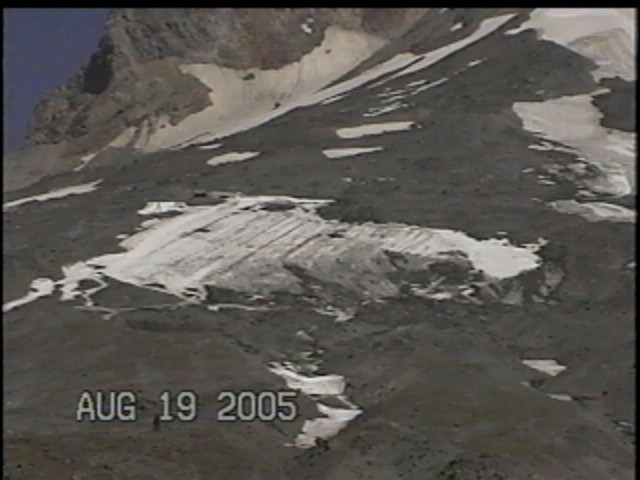A thin snow year and a hot summer have forced an early end to the Mount Hood summer season for skiers and snowboarders, with a final public day of Sunday, August 2. Three large summer camps were granted a one-week extension to wrap up final sessions for campers who had already paid for camp and bought plane tickets to Oregon.
High Cascade Snowboarding Camp President Kevin English and other camp directors were hoping for clearance from Timberline management to finish up the season for campers who have already signed up and paid. English was under the impression as late as Friday morning that High Cascade and Windells would be allowed to stage Session Six as planned. Mt. Hood Summer Ski Camps was also prepared to stage several more sessions.
Mountain managers originally made the decision Saturday to close the lifts for everyone at the end of Sunday, leaving camp directors to scramble to assemble a Plan B for campers already en route to Oregon.
Then Sunday rumors surfaced that the three biggest camps, High Cascade, Windells and Mt. Hood Summer Ski Camps, would indeed get another week on the snow. “We’re going to see what we can do for them,” Timberline spokesman Jon Tullis said Monday afternoon.
In the end English and co. prevailed, setting up one final session for summer campers on the remaining snow.
Mount Hood receives over 400 inches of snow at 6,000 feet of elevation in a typical winter, enabling the longest ski season in North America at Timberline. Lift service generally continues through Labor Day on the Palmer Snowfield, and at least 18 summer camps jockey for space on the training lanes and parks set up for racers and freeriders.
This past winter, however, Timberline got only 297 inches of snow, and July temperatures soared to melt what little snow did last until summer.
Timberline’s grooming crew worked hard to stockpile, protect and move around snow to extend the season on Palmer. Groomers recently sacrificed two training lanes 4-5 to push snow onto the Palmer midstation road.
“It is remarkable that we have been able to provide such a great product as long as we did this summer, considering the low snow year and hot summer temperatures we’ve been experiencing,” said Timberline area operator Jeff Kohnstamm, president of RLK and Company. “We all owe a debt of gratitude to our wonderful mountain crew.”
Management decided to cut the season short this summer due to safety and logistical concerns. Transporting fuel and salt to snow cats parked near the bottom of Palmer becomes a challenge once the majority of the snow melts, as do public lift ticket sales. Ski patrol access to help injured people also becomes more difficult.
The August 2 closure makes 2015 the shortest summer snow season on Mount Hood since the Palmer Lift was built in 1978, although as this photo from Robin Cressy of Mt. Hood Summer Ski Camp shows, snow coverage at the end of the season in 2005 was arguably even worse:
As a result of the poor snow year, revenues are down for most summer camps on Mount Hood, which is why they are fighting hard for one last session on the snow this week.
Timberline spokesman Jon Tullis said the lodge has not suffered much from the lack of snow, because tourism is booming this summer due to a strong U.S. economy. “Our lodging, food, and attractions business is very robust,” Tullis said. “Occupancy and visitation have been strong.”
Timberline is renowned for its long-running snow sports season, but it is also a summer center for hiking, biking, tour groups, special events and dining and lodging, and all of those activities have been popular this summer, Tullis said. Foot traffic on the Pacific Crest Trail has been especially high following the far-reaching success of the book and film Wild.
This gallery of photos from Robin Cressy illustrates why the 2015 summer season shut down early:
{igallery id=7803|cid=61|pid=2|type=category|children=0|addlinks=0|tags=|limit=0}
It is hard to look at some of those photos and not wonder whether something is fundamentally wrong. Record temperatures have soared to over 100 degrees Fahrenheit in numerous Oregon cities this July, raising disturbing questions about the long-term climate of the Pacific Northwest and its Cascade Range glaciers. According to a peer-reviewed climate report issued by NOAA on July 16, 2015, 2014 was the warmest year on record globally, and the level of greenhouse gases in the Earth’s atmosphere is at an all-time high. The past two winters on Mount Hood have brought repeated storms of rain instead of snow, followed by strange June-uary inversions that melted away snowpack early.
Does all of the above spell doom for Mount Hood’s $250 million snow economy? Tullis, English, Cressy and other Mount Hood summer regulars certainly hope not. Like most skiers and snowboarders, they prefer to take a glass-half-full approach when it comes to predicting future snow levels.
“We’ll be back next year,” says Tullis. “The Palmer Snowfield is very resilient.”
The 2015-16 season is expected to be an El Nino year, which generally means warm, wet weather. But most meteorologists are hesitant to predict snow seasons months in advance, and when they do attempt to predict the distant future, they often end up being wrong.
Last modified: July 31, 2015


